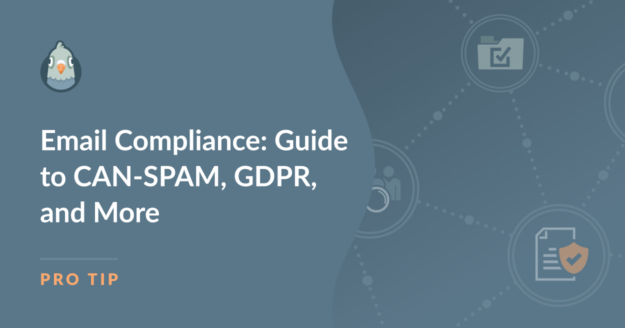AI Summary
Navigating the complex world of email compliance can feel like a daunting task, but it doesn’t have to be!
Whether you’re a seasoned email marketer or just getting started, understanding the rules and regulations that control email communications is crucial for protecting your business and building trust with your audience.
In this guide, I’ll break down the essentials of email compliance, covering key regulations like CAN-SPAM, GDPR, and more. So, let’s dive in and ensure your emails are not only reaching inboxes but also keeping you on the right side of the law.
Email Compliance: Guide to CAN-SPAM, GDPR, and More
In This Article
What Is Email Compliance?
Email compliance refers to the adherence to laws and regulations that govern the sending of commercial emails.
These regulations aim to protect consumers from spam, fraudulent messages, and privacy violations. Common elements across various regulations include obtaining explicit consent from recipients, providing clear opt-out mechanisms, and ensuring transparent communication regarding the sender’s identity.

Compliance also involves safeguarding personal data and respecting users’ privacy preferences. The significance of email compliance lies in maintaining trust with recipients and avoiding legal repercussions.
Non-compliance can lead to severe consequences, including hefty fines, legal actions, and damage to a company’s reputation. Ensuring email compliance is crucial for building a sustainable and ethical email marketing strategy.
Editor’s Note: While we’re well-versed in all things email compliance at WP Mail SMTP, please keep in mind that this article is just a guide, and is not intended to provide legal advice.
Understanding the CAN-SPAM Act

The CAN-SPAM Act was enacted in 2003 and sets the rules for commercial email and messages. This act gives recipients the right to have businesses stop emailing them and enforces tough penalties for violations. In a nutshell, it protects email users from spam!
Key requirements of the CAN-SPAM Act include:
- Accurate sender information; the “From,” “To,” and routing information is correct and identifies the person or business who sent the message
- Subject lines must be clear and not misleading
- Emails must include a clear and conspicuous opt-out mechanism, allowing recipients to easily unsubscribe from future emails
- Each email must contain the sender’s valid physical postal address.
Read More: Why Your WordPress Emails Are Going to Spam (+ How to Fix It)
Businesses must also monitor and ensure that 3rd party email marketing services comply with these regulations. Otherwise, the punishments can be severe.
Non-compliance can result in penalties of up to $43,792 per violation! So, adherence to the CAN-SPAM Act is crucial for any business engaged in email marketing.

Where the CAN-SPAM Act is all about what’s being sent to a person, GDPR is concerned with what’s being taken from them.
The General Data Protection Regulation (GDPR), which came into effect in May 2018, is a comprehensive data protection law. It applies to all organizations processing the personal data of individuals within the European Union.
Key requirements of GDPR include:
- Obtaining explicit consent from individuals before collecting their data
- Providing individuals with the right to access their data
- Ensuring the right to erasure, allowing individuals to request the deletion of their data
- Adherence to data protection principles such as data minimization, accuracy, and confidentiality
- Organizations are required to appoint a Data Protection Officer (DPO) if they process large volumes of personal data or handle sensitive data.
Read More: The Best GDPR Plugins for WordPress
Additionally, GDPR mandates that data breaches must be reported to the relevant authorities within 72 hours.
As is the case with the CAN-SPAM Act, non-compliance with GDPR can result in severe penalties. Consequences include fines of up to €20 million (approximately $21.8 million) or 4% of the global annual turnover, whichever is higher.
That’s why adhering to GDPR is essential for protecting individuals’ privacy rights and maintaining the trust of customers and stakeholders.
Other Notable Email Compliance Regulations

Beyond the CAN-SPAM Act and GDPR, several other significant email compliance regulations exist worldwide:
- Canada’s Anti-Spam Legislation (CASL) is one of the strictest, requiring express consent from recipients, clear identification of the sender, and an easy opt-out mechanism.
- In the UK, the Privacy and Electronic Communications Regulations (PECR) complement GDPR by setting specific rules for electronic marketing, including emails and cookies.
- Australia’s Spam Act mandates that commercial emails must contain accurate sender information, a functional unsubscribe option, and be sent with the recipient’s consent.
Read More: IP Warming + Email Example Schedules – A Complete Overview
While these regulations share common goals of protecting consumers and ensuring transparent communication, they each have unique provisions and enforcement mechanisms.
Understanding these differences is crucial if your business operates internationally. Take this information to heart to ensure comprehensive compliance and avoid potential fines and reputational damage.
Best Practices for Email Compliance
So, what’s a business to do?
To achieve and maintain email compliance, you should adopt several best practices.
First, building and maintaining an opt-in list is crucial. This involves obtaining explicit consent from recipients before sending emails and regularly updating the list to remove inactive or unsubscribed contacts. Clear and concise privacy policies should be communicated to recipients, outlining how their data will be used and protected.

Then, regular audits and updates of compliance practices are necessary to keep up with evolving regulations. Training and educating staff on compliance requirements ensures everyone understands their responsibilities.
You might also consider compliance tools and software that can automate and streamline processes. These tools can help with managing consents, handling unsubscribe requests, and monitoring email campaigns for compliance.
Practices like these not only help your business adhere to regulations but also foster trust and transparency with your audience.
Practical Steps to Ensure Compliance
The best practices listed above are ideal, but implementing practical steps to ensure email compliance involves a systematic approach to your email marketing strategy.
Start by setting up compliant email campaigns that adhere to all relevant regulations. This means including accurate sender information, clear subject lines, and a visible opt-out option in every email.

You should also manage and document consents meticulously, double-checking that you have explicit permission from recipients before sending them emails, and maintaining records of these consents.
Regularly update and secure your email lists to remove inactive or unsubscribed contacts and protect recipients’ data, too. Handle unsubscribe requests promptly and efficiently to guarantee recipients are removed from your mailing list as soon as they opt-out.
Finally, be prepared to respond to data subject access requests by providing individuals with access to their data and the ability to request its deletion.
By following these practical steps, your business can minimize the risk of non-compliance while also building a trustworthy and effective email marketing strategy.
FAQ
When it comes to email compliance, there’s a lot to learn and cover. These are some of the most frequently asked questions on the topic:
What is the difference between CAN-SPAM and GDPR?
The CAN-SPAM Act is a U.S. regulation focused on commercial email requirements, such as accurate sender information and clear opt-out mechanisms.
GDPR is an EU regulation that covers broader data protection and privacy rights, including obtaining explicit consent for data collection and the right to access and delete personal data.
How can I ensure my email marketing campaigns are GDPR compliant?
To ensure GDPR compliance, obtain explicit consent from recipients before sending emails, provide clear options for recipients to access and delete their data, and ensure transparent communication about how their data will be used.
Appoint a Data Protection Officer (DPO) if necessary, too, and report any data breaches within 72 hours.
What are the penalties for non-compliance with email regulations?
Penalties vary by regulation: CAN-SPAM violations can result in fines of up to $43,792 per email, while GDPR violations can lead to fines of up to €20 million (approximately $21.8 million) or 4% of the global annual turnover, whichever is higher.
Other regulations like CASL and PECR also impose significant fines for non-compliance.
What should be included in a compliant email opt-out mechanism?
A compliant opt-out mechanism should be easy to find and use, allowing recipients to unsubscribe from future emails with a single click.
The process should be straightforward, and opt-out requests must be honored promptly, typically within 10 business days.
Are there specific tools that can help with email compliance?
Yes, several tools and software solutions can assist with email compliance.
These include email marketing platforms with built-in compliance features, consent management tools, and data protection software that helps manage and secure personal data.
WP Mail SMTP, for example, is an email deliverability tool that is compliant with the regulations I’ve covered here.
Next, Consider Your Subject Line
I mentioned earlier the importance of your email subject line. Not only does it inform your reader and provoke an action, but it also keeps your business email compliant.
Coming up with catchy subject lines yourself, though? You might want a bit of help with that. Be sure to take a look at our guide on generating email subject lines with AI for some inspiration.
Ready to fix your emails? Get started today with the best WordPress SMTP plugin. If you don’t have the time to fix your emails, you can get full White Glove Setup assistance as an extra purchase, and there’s a 14-day money-back guarantee for all paid plans.
